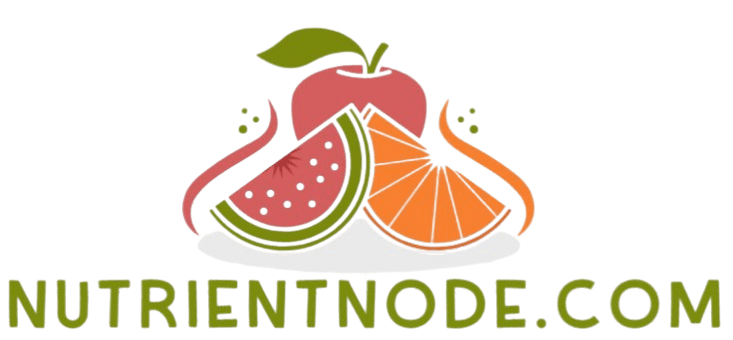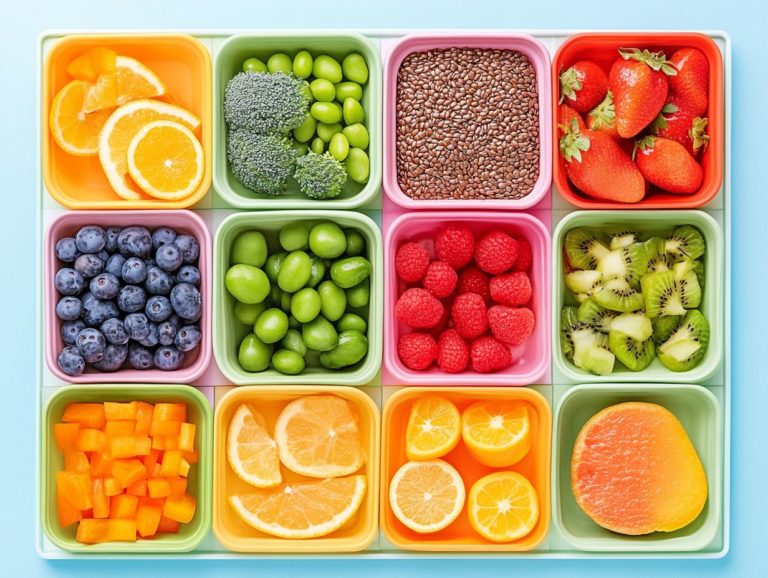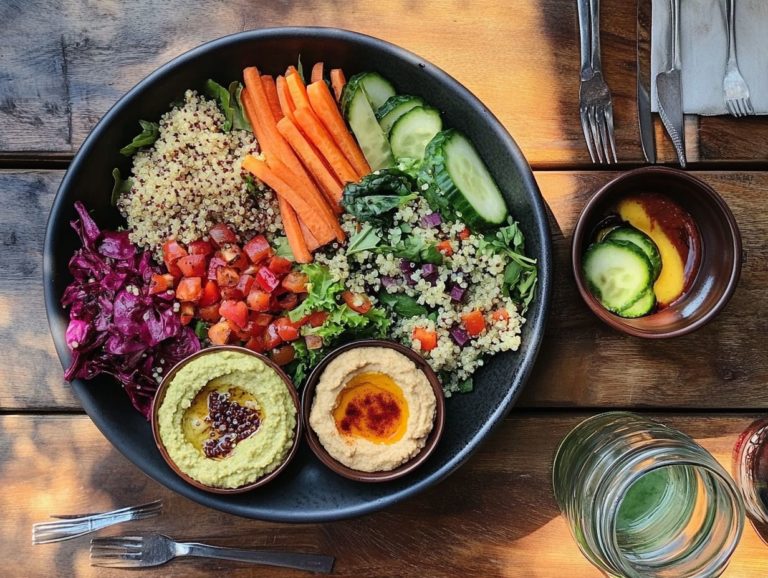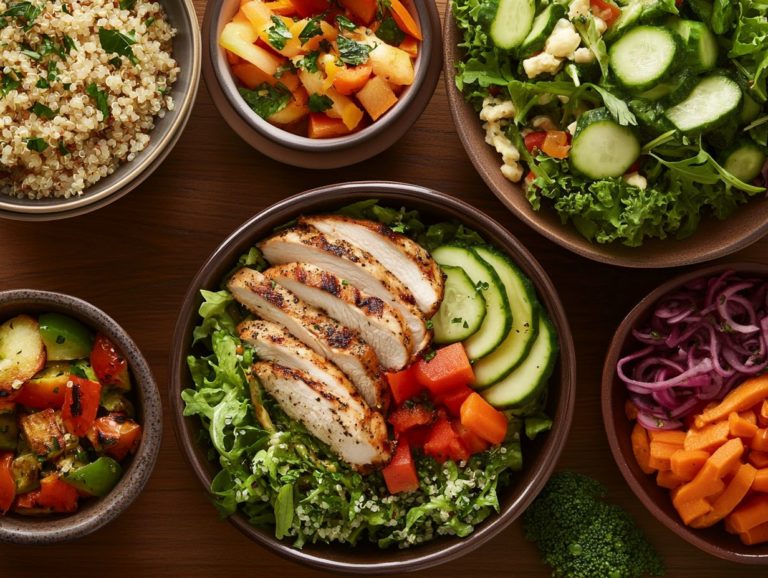Meal Planning for Different Age Groups
Meal planning is an essential skill that can revolutionize your approach to nutrition at every stage of life. Whether you’re a busy parent striving to meet your child’s dietary needs, an adult navigating the complexities of healthy eating, a senior with specific nutritional requirements, or an athlete looking to elevate performance, personalized meal planning can truly make a difference!
This article delves into meal planning strategies tailored for children, adults, seniors, athletes, and even vegetarians and vegans. It provides you with practical tips and guidelines to help you reach your health goals. Let s dive into the world of meal planning!
Contents
- Key Takeaways:
- Meal Planning for Children
- Meal Planning for Adults
- Meal Planning for Seniors
- Meal Planning for Athletes
- Meal Planning for Vegetarians and Vegans
- Frequently Asked Questions
- Why Should You Meal Plan for Every Age Group?
- What Should You Consider When Meal Planning for Toddlers?
- How Can Meal Planning Benefit Teenagers?
- What Are Some Meal Planning Tips for Adults?
- How Can Meal Planning for Seniors Improve Their Overall Health?
- What Are Some Common Challenges When Meal Planning for Multiple Age Groups?
Key Takeaways:
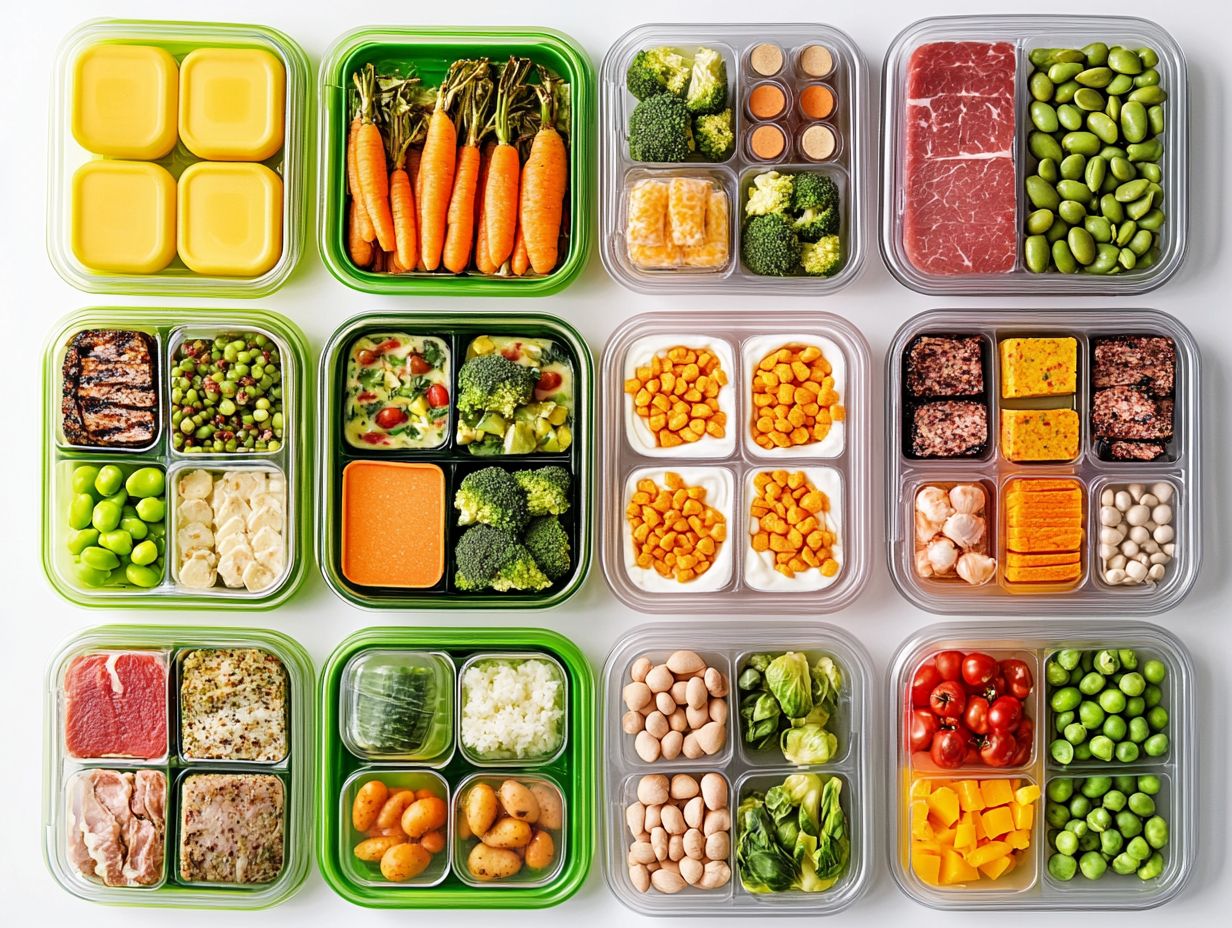
Meal planning is a strategic way to plan and prepare meals for different age groups to meet their unique nutritional needs. Children require a mix of all food groups to support growth and development, while adults should focus on a balanced and varied diet. For seniors and athletes, specific dietary needs should be considered, and vegetarians and vegans can meet their nutrient requirements through a variety of plant-based foods.
What is Meal Planning?
Meal planning is your strategic ally in organizing meals ahead of time to meet your specific nutritional goals while fostering healthy eating habits. By understanding the basics of various food groups, you can craft balanced meal plans tailored to your unique dietary needs, ensuring optimal nutrient intake.
This thoughtful practice often includes preparing a grocery list, streamlining your shopping experience and steering you away from unhealthy choices. It paves the way for a more active lifestyle and effective weight management.
Engaging in meal planning plays a vital role in sustaining your energy levels throughout the day by aligning your meals with your caloric needs. It promotes mindful portion sizes, encouraging you to eat thoughtfully, which can significantly reduce food waste and curb overeating.
Incorporating practical cooking tips, such as batch cooking or using versatile ingredients, can simplify the entire process. By adhering to dietary guidelines, you and your family can enjoy a diverse array of meals that cater to various preferences and dietary restrictions, making the journey to nutritious eating both enjoyable and inclusive.
Meal Planning for Children
Meal planning for children is crucial in providing them with the proper nutrition they need to support their growth, energy requirements, and overall development. By involving them in the meal planning process, you not only address their food preferences but also help cultivate lifelong healthy eating habits!
Nutritional Needs and Recommended Foods
Understanding the nutritional needs of children means recognizing the key food groups that are vital for their growth, such as fruits, vegetables, and protein-rich foods. You ll want to ensure they enjoy healthy snacks that cater to their tastes.
To effectively promote healthy eating habits, it s essential to emphasize appropriate portion sizes tailored to each child’s age and activity level. Incorporating a vibrant array of nutrient-dense foods those that provide a high amount of nutrients relative to their calorie content can greatly enhance their diet while respecting individual preferences.
For example, if a child has lactose intolerance, they might find almond milk or dairy-free yogurt to be delightful, calcium-rich alternatives. Creating flexible meal plans featuring whole grains, lean proteins, and an abundance of colorful fruits and vegetables can seamlessly accommodate various dietary restrictions whether they re dealing with nut allergies or gluten sensitivities.
These thoughtful considerations not only help children forge healthier relationships with food but also ensure they receive the essential nutrients necessary for their active lifestyles.
Meal Planning for Adults
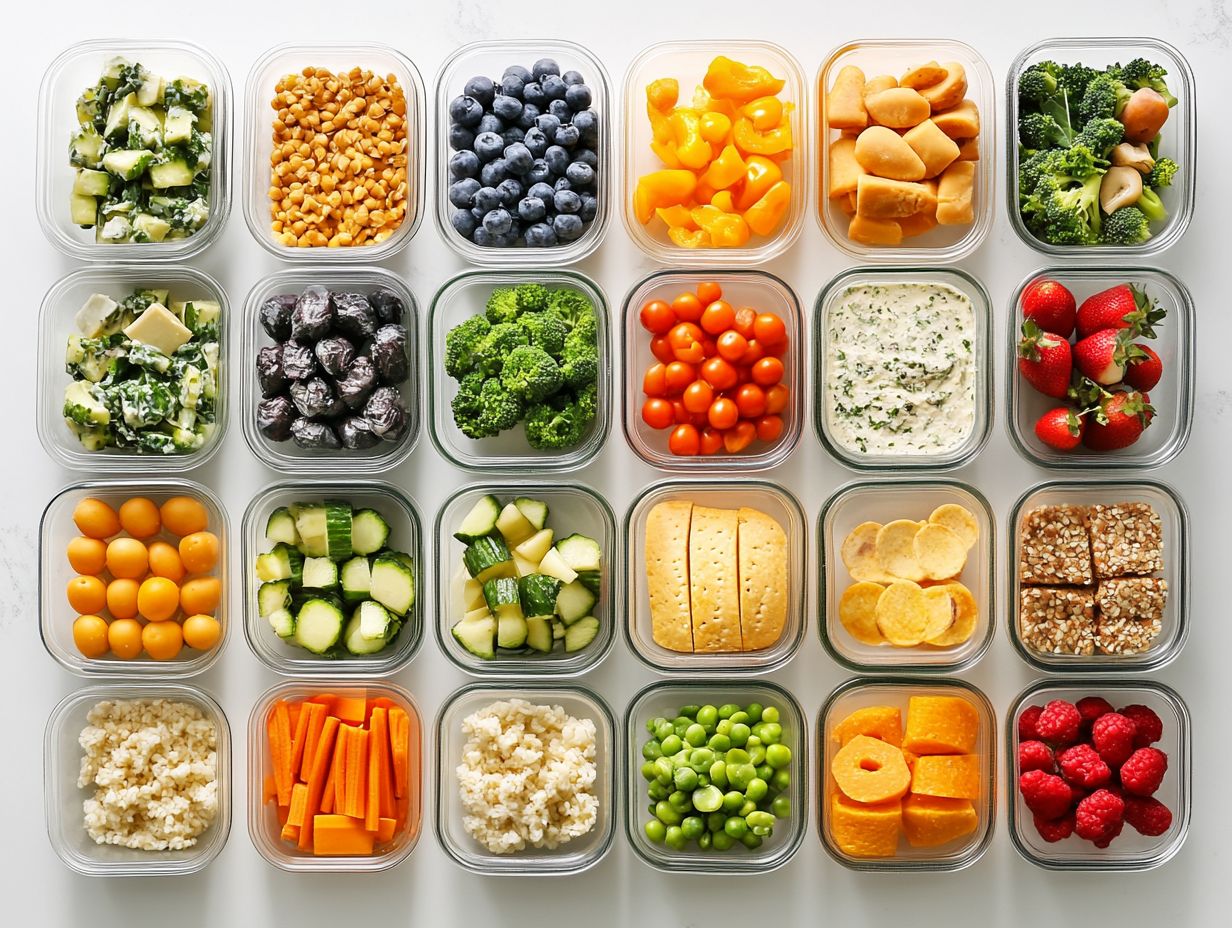
Meal planning for adults represents a proactive strategy to uphold healthy eating habits, all while aligning with dietary recommendations that cater to your unique nutritional needs and lifestyle choices. This approach not only assists in managing your food budget but also guarantees a balanced intake of essential nutrients.
Thoughtfully considering portion sizes along the way can lead to healthier choices and improved well-being.
Healthy Eating Guidelines and Tips
Adhering to healthy eating guidelines is vital for maintaining a balanced nutrient intake. This promotes overall well-being and helps lower the chance of long-term illnesses. It enables one to make informed food choices and adopt practical cooking techniques.
To cultivate a well-rounded diet, it s essential to incorporate a variety of food groups, including:
- Fruits
- Vegetables
- Whole grains
- Lean proteins
- Healthy fats
This diversity not only boosts nutrient intake but also keeps meals exciting and enjoyable. Hydration is crucial; drinking enough water throughout the day enhances digestion and energy levels.
Adjusting meal schedules to fit individual needs allows for consistent nutrient absorption. Using simple cooking methods, such as steaming and roasting, preserves essential vitamins and minerals, transforming each meal into a delightful and nutritious experience.
Meal Planning for Seniors
Meal planning for seniors requires a thoughtful approach to specific nutritional needs. As individuals age, dietary changes and heightened health considerations come into play, significantly influencing food choices.
Effective meal planning can tackle hydration needs and accommodate prevalent food allergies, ensuring a balanced and healthful diet tailored to seniors’ lifestyles.
Special Considerations and Nutritional Requirements
Seniors often encounter unique nutritional needs that require thoughtful consideration. This includes dietary restrictions and an increased intake of protein-rich foods and essential vitamins to support optimal health.
Dietary restrictions can stem from various conditions such as diabetes, hypertension, or lactose intolerance, adding complexity to meal planning. For example, when managing diabetes, prioritize low-glycemic foods, which refer to how much a food raises blood sugar levels, like whole grains, legumes, and leafy greens. Avoid sugar and refined carbohydrates.
To enhance meals, consider incorporating flavorful herbs and spices to counteract blandness associated with dietary limits. Pairing protein-rich options like quinoa or fish with vibrant, colorful vegetables elevates both taste and nutrition.
Carefully planning balanced meals harmonizes health and flavor, enhancing adherence to dietary guidelines.
Meal Planning for Athletes
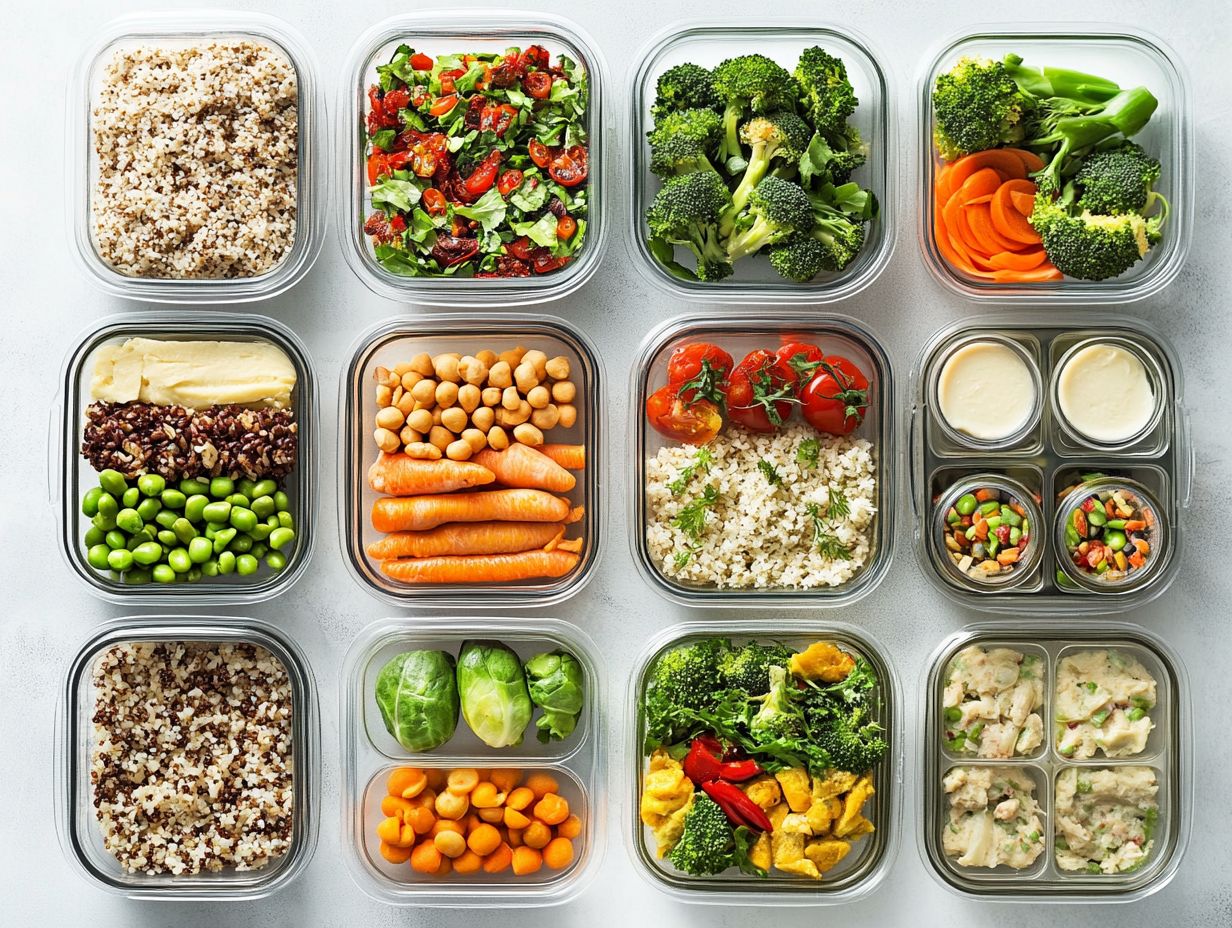
Meal planning for athletes is a purposeful approach designed to elevate performance and optimize recovery.
By aligning dietary intake with specific energy needs and essential nutrient requirements, athletes can achieve peak physical activity and excel in their endeavors.
Optimizing Performance and Recovery
Optimizing performance and recovery hinges on incorporating nutrient-dense foods. This ensures athletes stay adequately hydrated and energized for training and competition.
Prioritize a diverse array of whole foods rich in carbohydrates, proteins, healthy fats, and essential vitamins and minerals. For example, a pre-training meal of oatmeal adorned with fresh berries and a scoop of nut butter provides a balanced mix of slow-release carbohydrates and healthy fats to fuel workouts.
After training, a smoothie made with protein powder, spinach, banana, and almond milk can replenish nutrients and aid muscle recovery. Hydration is key; consistently sip water throughout the day and enjoy electrolyte-packed beverages during longer sessions.
Strategically timing meals and snacks around workouts significantly enhances performance and optimizes recovery.
Meal Planning for Vegetarians and Vegans
Meal planning for vegetarians and vegans is essential for balanced nutrition. This practice highlights a variety of nutrient sources.
By following dietary guidelines tailored to these lifestyle choices, one can embrace a healthful and satisfying culinary journey.
Nutrient Sources and Balanced Meal Ideas
Identifying nutrient sources is essential for crafting balanced meal ideas that cater to vegetarians and vegans. This guarantees delicious, balanced meals that fuel your body!
One effective strategy is to explore various plant-based protein sources, such as lentils, chickpeas, quinoa, tempeh, and edamame. Imagine a hearty lentil stew paired with a side of perfectly roasted vegetables.
You could also enjoy a quinoa salad adorned with chickpeas and a zesty dressing for a refreshing lunch option. Incorporating tofu or tempeh into stir-fries allows for diverse flavor profiles that cater to different taste preferences.
Consider a meal plan that includes:
- Start your day with energizing overnight oats topped with creamy almond butter.
- Enjoy a vibrant grain bowl filled with mixed greens and roasted veggies for lunch.
- Indulge in a spicy edamame and vegetable curry for dinner.
This approach not only ensures adequate protein intake but also presents a colorful array of nutrients essential for overall health.
Frequently Asked Questions

Why Should You Meal Plan for Every Age Group?
Meal planning for different age groups has several benefits, including ensuring balanced and nutritious meals. For those with specific requirements, meal planning for special dietary needs can also save time and money.
What Should You Consider When Meal Planning for Toddlers?
When meal planning for toddlers, include a variety of nutrient-rich foods and offer smaller portion sizes. Introduce new foods gradually to avoid picky eating.
How Can Meal Planning Benefit Teenagers?
Meal planning can benefit teenagers by providing essential nutrients for growth and development. It also promotes healthy eating habits and helps them save money by avoiding frequent takeout.
What Are Some Meal Planning Tips for Adults?
For adults, helpful meal planning tips include incorporating a balance of all food groups and choosing whole, unprocessed foods. Preparing meals in advance is also crucial for busy days.
How Can Meal Planning for Seniors Improve Their Overall Health?
Meal planning for seniors can enhance their overall health by ensuring adequate intake of essential nutrients. It helps reduce the risk of chronic diseases and promotes independence with easy-to-eat meals.
What Are Some Common Challenges When Meal Planning for Multiple Age Groups?
Common challenges in meal planning for multiple age groups include catering to different taste preferences and accommodating dietary restrictions. Finding meals that suit everyone’s needs and schedules can also be tricky.
Ready to start your meal planning journey? Let s get cooking!
